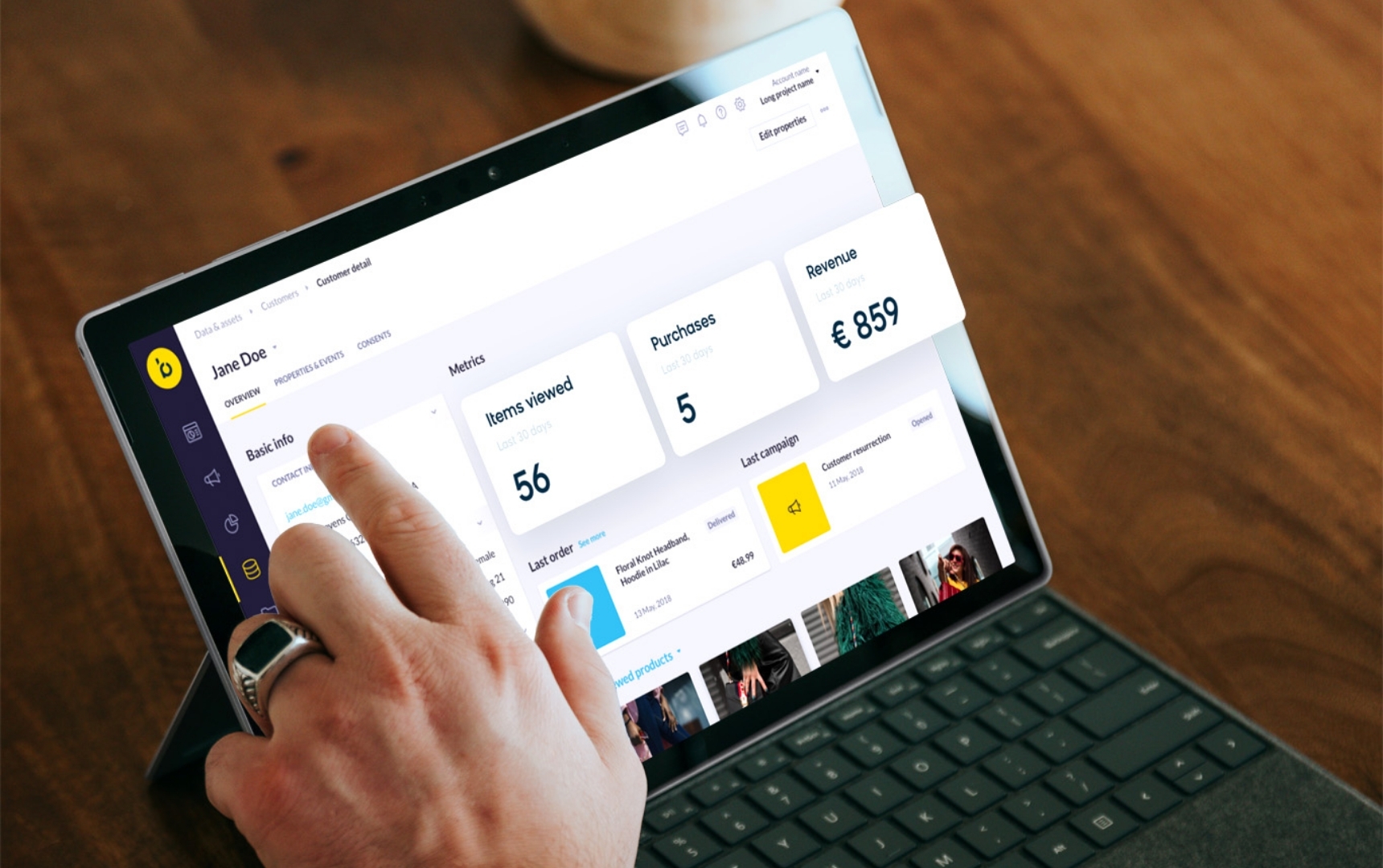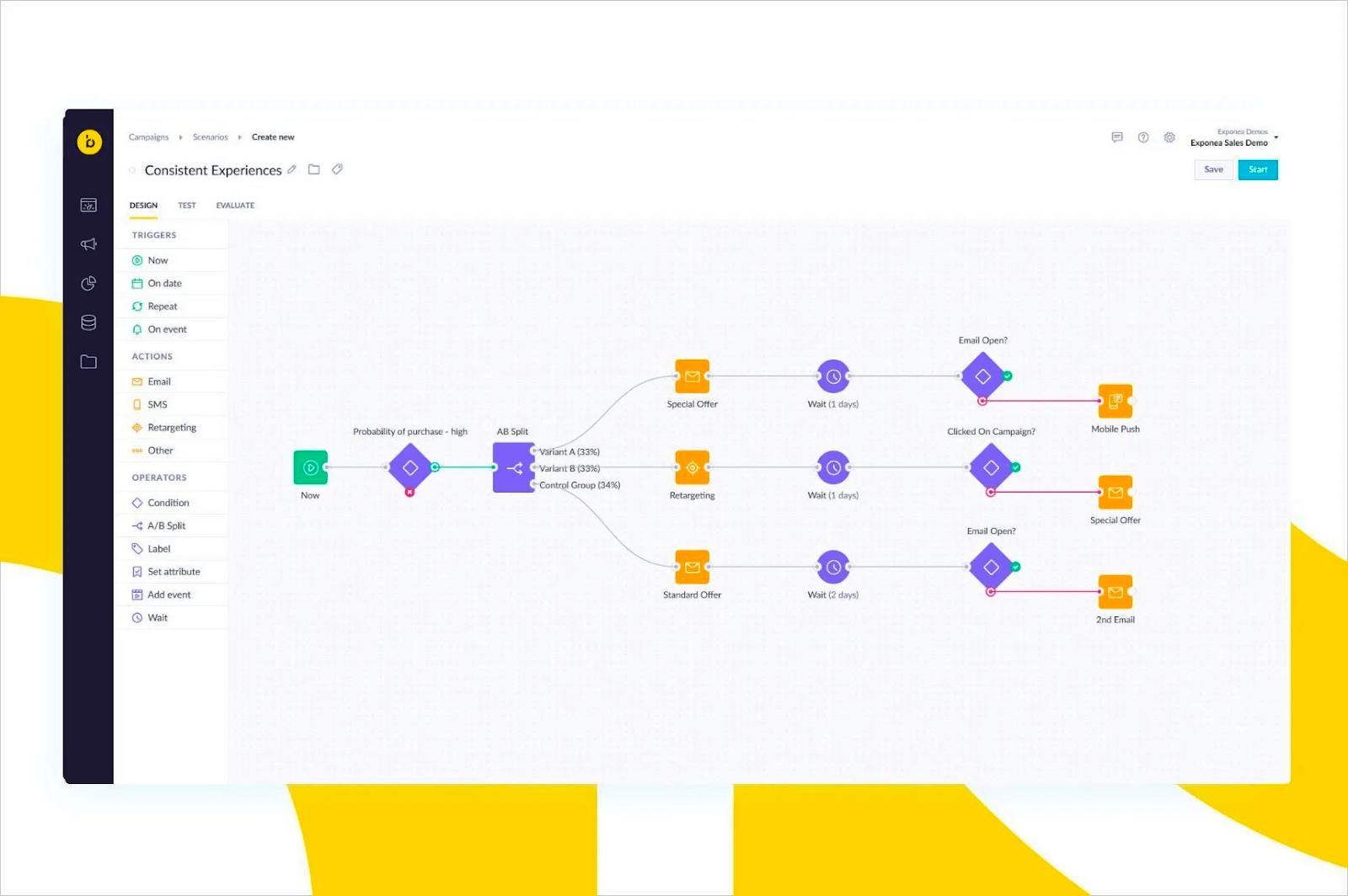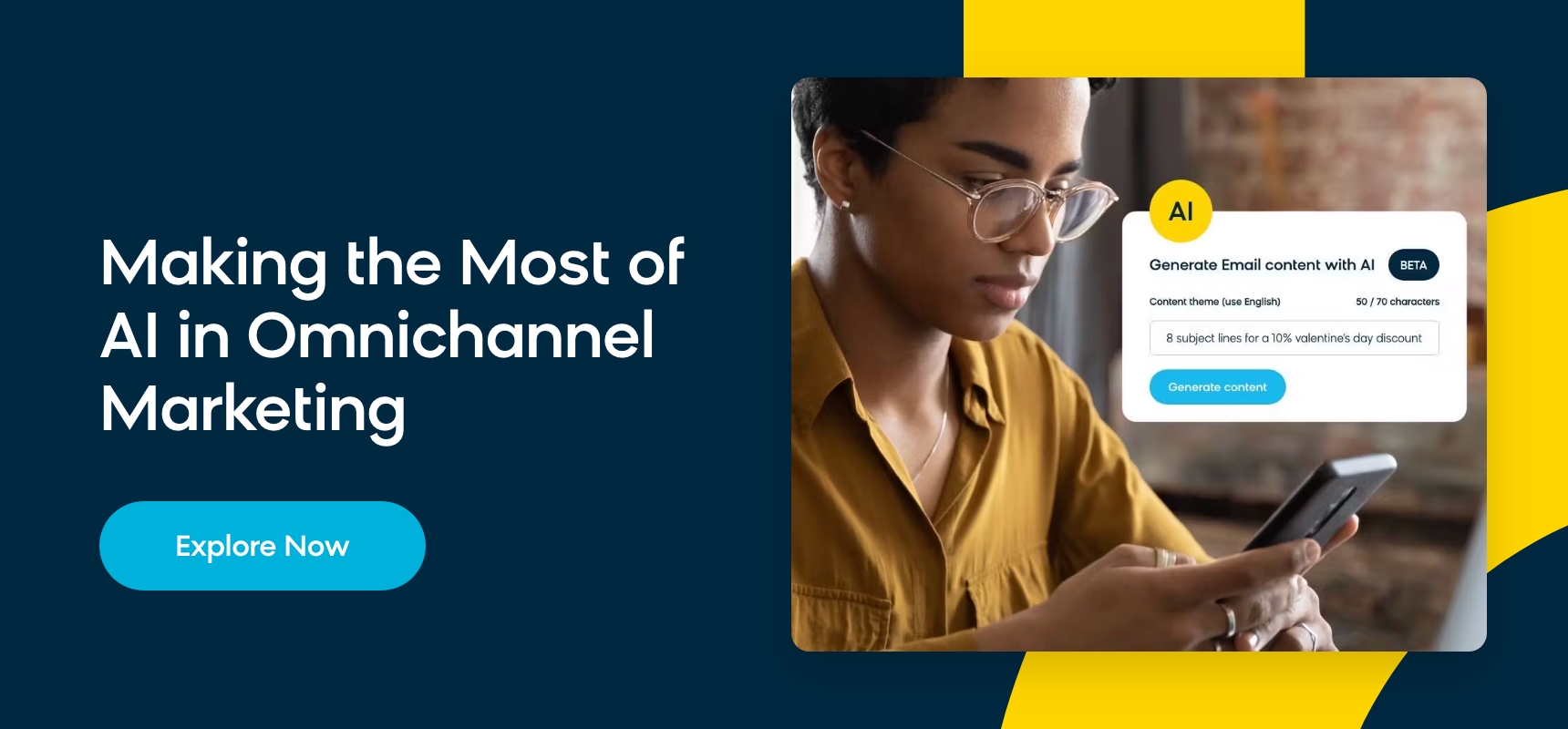Omnichannel vs. Multichannel: What’s the Difference and How To Choose?
By Ian Donnelly
04/30/2024

Are you confused about the difference between omnichannel vs. multichannel marketing? If so, you're not alone.
Since both involve using more than one marketing channel to reach an audience, these terms are often used interchangeably. But there are important distinctions between them that are vital for marketers to understand.
In this article, we'll dive into the key differences between these two marketing approaches and help you determine which is right for your business.
- Multichannel marketing treats each channel as a tool unto itself, aiming to reach as many customers as possible.
- Omnichannel marketing focuses on syncing your marketing efforts and providing a seamless and personalized customer experience across all channels.
- Successful omnichannel marketing requires a comprehensive understanding of your customers and their relationship with your brand, as well as an interconnected and personalized customer journey that can adapt in real time.
The Difference Between Omnichannel and Multichannel Marketing
Omnichannel vs. multichannel marketing is not the dichotomy you might expect.
The difference between omnichannel and multichannel marketing comes down to the focal point of the two strategies. Multichannel marketing involves reaching and interacting with customers using more than one channel, while omnichannel marketing goes beyond amassing individual channels and treats the entirety of your marketing touchpoints as a comprehensive brand experience.
While multichannel marketing can utilize an array of channels — both direct and indirect, online and offline — it doesn’t bring them all together in one unified journey. Omnichannel marketing, on the other hand, is a holistic approach to customer engagement across every channel, creating a seamless customer journey no matter where shoppers interact with your brand.
This difference may seem minor, but it has major implications for your digital marketing strategy.
Channel-Focused vs. Customer-Focused
The debate between omnichannel vs. multichannel really boils down to a channel-focused vs. a customer-focused marketing strategy.
With multichannel marketing, the ultimate goal is to use all your marketing channels (such as email, SMS, social media, etc.) to reach as many customers as possible. Each channel functions as a tool unto itself, speaking to your audience without input or insights from other marketing touchpoints.

Omnichannel marketing, on the other hand, focuses on providing a seamless, connected, and personalized customer experience across all channels. The goal is to make it easy for customers to interact with your brand, no matter how they choose to do so.
It puts the customer at the center of your entire marketing efforts, allowing them to move between channels and still receive a consistent customer experience with your brand.
Quantity of Touchpoints vs. Quality of Touchpoints
Because channels are siloed with a multichannel approach to marketing, it relies on a large quantity of customer engagement touchpoints to work. You need as many channels as possible working to make your message visible, presuming that the more your customers see your brand, the better.
This strategy inevitably leads to a disconnected experience for your customers — it’s likely that the messaging they receive won’t speak directly to where they are in the buying process, or they may see the exact same message multiple times through multiple channels. (This type of repetition isn’t necessarily a good thing, either.)
Omnichannel marketing, on the other hand, focuses on quality over quantity. The messages each customer receives are customized to the specific channel they’re using, the previous interactions they’ve had with your brand, and the current stage they’re at in their customer journey.
Static Messaging vs. Customized Messaging
As we mentioned above, a multichannel strategy often involves using the same message across multiple channels. While this can be efficient, it can also be impersonal and ineffective.
If your company is having a sale on women’s flip flops, for example, you don’t want the same static message bombarding your audience across multiple channels — especially if they’re not interested in women’s flip flops.
Since omnichannel marketing involves customizing messaging for each channel and each customer, every touchpoint is treated as a part of the customer experience. This way you can make sure all your channels are working together, not just alongside each other. This can lead to more customer engagement and shopping experiences that feel intentionally constructed.
An Example of Omnichannel vs. Multichannel Marketing
To give you a better idea of the differences between these approaches, let's take a look at some examples of how these two strategies play out in the real world.
An Example of Multichannel Marketing
To understand how a multichannel strategy works, you have to consider the last online experience you had with a company that overwhelmed you with marketing ads. We’ve all been irritated by a marketing campaign that follows us everywhere we go, saying the same thing over and over on multiple channels.
You might receive an email from a business advertising a sale on a specific product, then receive direct mail with the same sale, and see the message again as a banner ad when you visit a website or your favorite social media channels.
While having all these touchpoints may seem effective, they don’t take into consideration that the message didn’t work the first time you saw it, or the second, or the third. Soon, it feels like the advertisement is following you around, chasing you to purchase, even though it doesn’t personally speak to your wants or needs.
An Example of Omnichannel Marketing
With omnichannel marketing, companies can make sure their messaging is always catered to their customers. It’s the most effective way to connect with your audience on a deeper level, which is why companies like Whisker have adopted an omnichannel approach to strengthen their efforts.
Whisker is a leader in connected pet care accessories, including bringing the first automated, self-cleaning litter box to market in 2000. Before opting for an omnichannel marketing strategy to further promote its innovative offerings, the company was hindered by data silos, which were preventing Whisker from creating truly personalized experiences for its customers. It needed a way to connect its marketing channels, collect all its user data and behaviors, and also understand what messaging resonates (or doesn’t) with customers.
To find the best omnichannel approach for its marketing, Whisker turned to Bloomreach Engagement to run A/B and multivariate tests on its messaging to see how customers interact with the content.
The company wanted to be sure its marketing efforts were meeting the needs of the audience and speaking to where they were in the buying process, so it tested whether showing users persistent campaign messaging would impact results when compared to those who were shown different messages throughout the customer journey.
This initial test drove a 107% lift in conversion rates, as well as a 112% increase in revenue for users who clicked through to the website — all because Whisker worked to find the exact right message for its ideal audience.
How To Develop a Successful Omnichannel Marketing Strategy for Your E-commerce Business
If you're interested in developing an omnichannel marketing strategy for your business, here are some key steps to get started.
Unify Your Data To Understand Your Customers
When customer data is fragmented, it can be challenging for marketers to get a complete picture of the individual customer journey and deliver seamless omnichannel experiences at scale. This is the biggest drawback of multichannel marketing — your channels don’t work together, so all your data can’t unite for a better understanding of your customers. That’s why unifying your customer data into a single source of truth is so important.
By bringing together and cataloging data from various sources, marketers can gain a comprehensive view of each customer and their unique buying patterns and behaviors. This is a crucial step in crafting an omnichannel strategy that speaks directly to each customer’s needs.
To achieve data unification, you need a single customer view — a database with customer profiles that indexes all the relevant data (such as purchase history, site activity, product recommendations, etc.) for every individual person who interacts with your business.

With a single customer view, marketers know all the details they need to deliver more relevant, targeted messages, improving the customer journey and strengthening the customer relationship.
Read This Next: A Definitive Guide to CDPs
Map Out Your Customer Journey
Once you’ve unified your data, it’s time to look at your customer interactions across all your touchpoints. You need to map out your customer journey to truly grasp where your customers are and how they are engaging with your brand.
What channel works best for speaking to a new audience that has barely ever interacted with your brand? Has email proven to be the best channel for your remarketing campaigns, or have abandoned cart campaigns been more successful through SMS? These are all valuable questions you can ask to analyze your customer interactions, segment your customers, and map out your customer journey.
Read This Next: The Ultimate Guide to Journey Orchestration
Connect and Align Your Channels
Once you've brought all your data together and understand where your customers interact with your brand, the next big step is to make sure that your channels can work together. When all your channels are operating in tandem, you can create a seamless customer experience that is informed by the data gleaned from previous interactions.

The best way to align your channels is to choose a comprehensive marketing solution that lets you create and orchestrate all your campaigns in one place. Your channels need to collaborate, operating as one to form a customer journey that feels connected and consistent.
While piecing together separate solutions is an option, getting them to integrate properly can be an uphill battle. With your channels woven together in a single platform, you can tailor all your campaigns across all channels to easily pivot when needed. Comprehensive solutions do this intuitively, with no barriers between your various channels and campaigns.
Read This Next: Why Siloed Email and SMS Marketing Platforms Fall Short Where All-in-One Solutions Succeed
Personalize Your Omnichannel Messaging
Personalization is the ultimate goal of an omnichannel strategy. You’re aiming to give customers a consistent, cross-channel experience that adapts to customer needs and goals in real time.
To do this, your marketing needs to be an up-to-the-minute conversation your brand is having with your audience — every interaction they have with your brand, across any touchpoint, needs to inform the next phase of your marketing efforts with that particular customer.
If a customer visited your site and browsed your selection of bathing suits, you could target them with summer-themed product recommendations. If they viewed your site on their phone, you could try appealing to them with an SMS campaign. And if they put an item in their cart and left your site without making a purchase, you could entice them back to your site with a price drop alert if the product goes on sale.
All of these examples illustrate omnichannel personalization on a 1:1 scale, offering customers exactly what they need in their particular stage of the buying journey.
Analyze and Test Your Strategy
Once you’ve implemented the previous steps, you can’t just sit back and watch your KPIs grow (as nice as that would be) — omnichannel strategies require continued analysis and testing to reach their full potential.
Remember, your marketing should always respond to the needs and wants of the customer, which change over time. This means that your marketing approach needs to adapt along with it, and the only way to ensure your efforts are as nimble as they need to be is by keeping track of what works and what doesn’t. Fine-tuning is crucial to provide the most seamless experiences possible.
With diligent analysis and smart testing, you can build better customer relationships that have a lasting impact on your business — like increased loyalty, customer lifetime value, and more.
The Role of AI in Omnichannel Marketing
To realize all these essential elements of omnichannel marketing, artificial intelligence needs to be woven into your strategy. Without it, your marketing team can’t comprehensively connect all your marketing efforts and provide the elevated customer experiences that your audience expects.
One major use case of artificial intelligence is the ability to analyze vast amounts of customer data from various channels in real time and consolidate it into a single source of truth. AI can also help you sync your marketing channels and deliver a consistent, cross-channel journey, allowing you to automate campaigns that adapt and unfold with each new interaction.
On the product discovery side, AI can create hyper-relevant product recommendations based on a customer’s individual data, predict behaviors for better campaign targeting, and cater to your audience’s preferences. Plus, it can help you fine-tune your strategy at every stage of the process, providing valuable insights that optimize the customer experience as a whole.
Without the help of artificial intelligence, there’s no marketing team with enough hours in the day to manually link the right data points to the right customers, painstakingly create campaigns that offer a consistent (and of course, personalized) experience for everyone, and orchestrate the right messages on the right channels at the right time for your target audience.
All in all, omnichannel marketing just isn’t feasible without AI, which is why you need a marketing solution powered by AI to make an omnichannel marketing approach work for your ecommerce business.
Read This Next: Making the Most of AI in Omnichannel Marketing
Bloomreach Engagement: The Complete Omnichannel Marketing Platform for E-commerce
Ready to offer your audience a seamless omnichannel experience driven by AI? Bloomreach Engagement is the perfect tool for the job.
Bloomreach Engagement is powered by Loomi, our AI built for ecommerce, to help you orchestrate a meaningful ecommerce experience across every channel, in real time, at scale.
Our comprehensive solution creates a unified view of all of your customer data and delivers personalized experiences that resonate with each individual, regardless of where they are in the customer journey. And with real-time omnichannel personalization across 13 channels, you’ll have everything you need to align your campaigns to each touchpoint and craft the best customer experience possible.
Explore our site to learn more on how Bloomreach Engagement can help you orchestrate the ideal customer journey.
Found this useful? Subscribe to our newsletter or share it.











